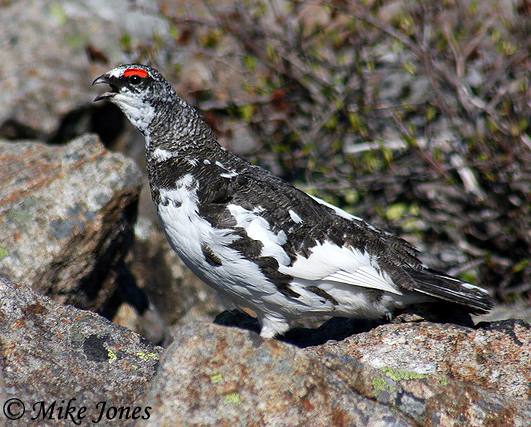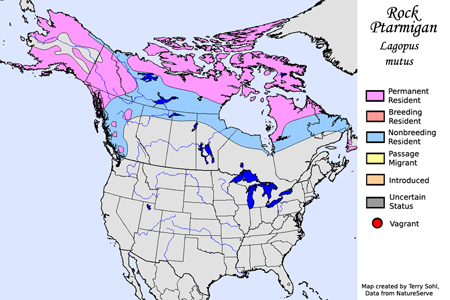| Length: 13 - 15 inches | Wingspan: 22 - 24 inches | Seasonality: Non-resident in South Dakota |
| ID Keys: White non-breeding. Non-breeding males - Dark upperparts, white underparts, splotchy black on sides, red stripe above eye | ||
 The
Rock Ptarmigan is found in harsh northern environments, either on the tundra
of Alaska and northern Canada, or on rocky slopes or above treeline in the
mountains. As with the other closely related
White-tailed Ptarmigan
and Willow Ptarmigan, the plumage turns white in winter, although the males
maintain a distinctive black stripe on the face that can be used to
distinguish Rock Ptarmigan from other Ptarmigan species. Rock Ptarmigan are
a popular food source and gamebird in parts of their range.
The
Rock Ptarmigan is found in harsh northern environments, either on the tundra
of Alaska and northern Canada, or on rocky slopes or above treeline in the
mountains. As with the other closely related
White-tailed Ptarmigan
and Willow Ptarmigan, the plumage turns white in winter, although the males
maintain a distinctive black stripe on the face that can be used to
distinguish Rock Ptarmigan from other Ptarmigan species. Rock Ptarmigan are
a popular food source and gamebird in parts of their range.
Habitat: Rock Ptarmigan are found in open habitats at higher elevations and in the northern tundra. On the tundra in the northern part of their range, they are found in areas of tundra interspersed with rocky outcrops and shrubby areas.
Diet: Mostly vegetarian, feeding on the buds, leaves,and seeds of dwarf birch, alder, and willows, as well as berries where available. They will also eat insects and spiders, with young birds feeding heavily upon these items upon leaving the nest.
Behavior: Forages by walking along the ground and clipping vegetation with its bill, or opportunistically picking up insects and spiders.
Nesting: Nests are built on teh ground in rocky, barren areas, typically at the base of alarge rock. The nest is a shallow depression, with a loose lining of lichen, grasses, and moss. The female alone tends the young, but the young must feed themselves upon leaving the nest.
Song: Rock Ptarmigan males give a throaty croaking rattle.
Migration: In the fall, birds at higher elevations typically move to lower elevations. Small flocks move also move southward together in the fall, leaving the most northern parts of its range and moving southward in Canada and to lower elevations.
Interactive eBird map: Click here to access an interactive eBird map of Rock Ptarmigan sightings
Similar Species: White-tailed Ptarmigan, Willow Ptarmigan
Conservation Status: Common and widespread. The IUCN lists Rock Ptarmigan as a species of "Least Concern".
Further Information: 1) WhatBird - Rock Ptarmigan
2) Audubon Guide - Rock Ptarmigan
3) TundraAnimals.net - Rock Ptarmigan
Photo Information: June 13th, 2010 - Rope Cove, Lewis Hills, Newfoundland - Mike Jones - Photo licensed under Creative Commons Attribution 2.0 Generic License.
| Click below for a higher-resolution map |
 |
| South Dakota Status: Non-resident in South Dakota |
Additional Rock Ptarmigan Images (coming soon!)
